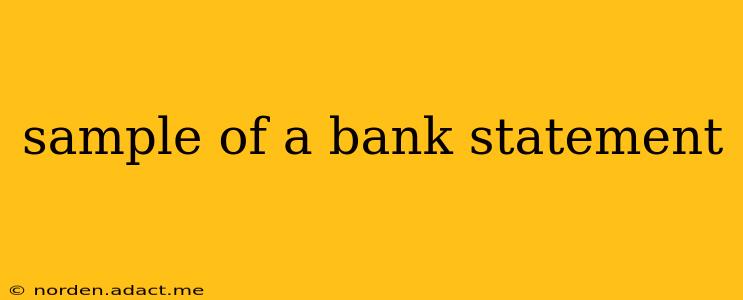A bank statement is a crucial financial document that summarizes your account activity over a specific period. Understanding how to read one is essential for managing your finances effectively. This guide provides a sample bank statement, explains its key components, and answers common questions.
What does a typical bank statement include?
A standard bank statement typically includes the following information:
- Account Holder Information: Your name and account number.
- Statement Period: The dates covered by the statement (e.g., January 1, 2024 – January 31, 2024).
- Beginning Balance: The amount of money in your account at the start of the statement period.
- Transactions: A detailed list of all transactions during the statement period, including deposits, withdrawals, checks, fees, and interest. Each transaction usually includes a date, description, and amount.
- Ending Balance: The amount of money in your account at the end of the statement period.
- Account Fees (if any): Charges for maintaining the account or specific services.
- Interest Earned (if applicable): Interest credited to your account during the period.
- Contact Information: The bank's contact details.
Sample Bank Statement (Simplified)
| Date | Description | Debit | Credit | Balance |
|---|---|---|---|---|
| 2024-01-01 | Beginning Balance | $1000.00 | ||
| 2024-01-05 | Deposit | $500.00 | $1500.00 | |
| 2024-01-10 | Groceries | $75.00 | $1425.00 | |
| 2024-01-15 | Rent Payment | $1200.00 | $225.00 | |
| 2024-01-20 | Salary Deposit | $2000.00 | $2225.00 | |
| 2024-01-25 | Online Shopping | $150.00 | $2075.00 | |
| 2024-01-30 | ATM Withdrawal | $100.00 | $1975.00 | |
| 2024-01-31 | Monthly Account Fee | $5.00 | $1970.00 | |
| 2024-01-31 | Ending Balance | $1970.00 |
Note: This is a simplified example. Real bank statements often include more detailed transaction descriptions and may have additional sections.
What information is crucial on a bank statement?
The most crucial information is the account number, the statement period, the beginning and ending balances, and the detailed list of transactions. Carefully reviewing these elements allows you to reconcile your personal records with the bank's records and detect any discrepancies.
How often do banks send statements?
Most banks send statements monthly, but some offer options for more frequent statements (e.g., weekly). You can usually adjust your statement frequency through online banking or by contacting your bank.
What if I notice an error on my bank statement?
If you notice any errors, such as incorrect transactions or discrepancies in the balance, contact your bank immediately. Provide them with the specific details of the error to enable them to investigate and rectify the issue. Keep copies of your statement and any supporting documentation.
Where can I find my bank statement?
You can typically access your bank statements through online banking, the bank's mobile app, or by requesting a paper copy from your bank branch.
This sample and explanation should give you a clear understanding of a typical bank statement. Remember to regularly review your statements to ensure accurate financial record-keeping.
